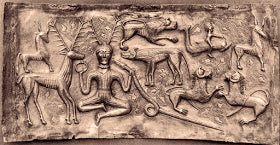Celts were already making #yogabangles in the 3rd century BC
Hundreds of years before #Yogananda popularized #yogabangles and recommended them to his disciple Janakananda, the Celts were making very similar bracelets and bangles, which they called torqs (torques, due to the twisted nature of their strands) during the Bronze Age (1000 to 300 BC).
Although they were usually made of gold, copper, and bronze; they wore them around the neck, above the elbow, or on their wrists (similar to those from Mohenjo-Daro, Pakistan, between 2600 and 1800 BC) as decorative items, for protection, and associated with the immortality of the soul.

(image of Torg of Burela, Spain, dated 3rd to 2nd century BC, 1812grams)
Germanic, Persian, Breton tribes, and, of course, the Celts used torques and included them in depictions of the gods in their mythology.

(image of a roman militar torq, bronze, dated 1st century BC)
Later, the Romans used torques as a distinctive military decoration, which was adapted for use, even to the point of hanging them from their clothing.
It's incredible to find such a clear connection between modern culture and yoga, represented in #yogabangles.

